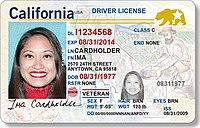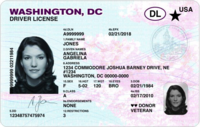
Back رخصة السواقه الامريكيه ARZ Führerschein (Vereinigte Staaten) German گواهینامه رانندگی در آمریکا Persian Carteiras de motorista nos Estados Unidos Portuguese Водительское удостоверение в США Russian
In the United States, driver's licenses are issued by each individual state, territory, and the District of Columbia rather than by the federal government due to federalism. Drivers are normally required to obtain a license from their state of residence. All states of the United States and provinces and territories of Canada recognize each other's licenses for non-resident age requirements. There are also licenses for motorcycle use. Generally, a minimum age of 15 is required to apply for a non-commercial driver license, and 25 for commercial licenses which drivers must have to operate vehicles that are too heavy for a non-commercial licensed driver (such as buses, trucks, and tractor-trailers) or vehicles with at least 16 passengers (including the driver) or containing hazardous materials that require placards. A state may also suspend an individual's driving privilege within its borders for traffic violations. Many states share a common system of license classes, with some exceptions, e.g. commercial license classes are standardized by federal regulation at 49 CFR 383.[1] Many driving permits and ID cards display small digits next to each data field. This is required by the American Association of Motor Vehicle Administrators' design standard and has been adopted by many US states. The AAMVA provides a standard for the design of driving permits and identification cards issued by its member jurisdictions, which include all 50 US states, the District of Columbia, and Canadian territories and provinces. The newest card design standard released is the 2020 AAMVA DL/ID Card Design Standard (CDS).[2] The AAMVA standard generally follows part 1 and part 2 of ISO/IEC 18013-1 (ISO compliant driving license). The ISO standard in turn specifies requirements for a card that is aligned with the UN Conventions on Road Traffic, namely the Geneva Convention on Road Traffic and the Vienna Convention on Road Traffic.[2]
According to the United States Department of Transportation, as of 2018, there are approximately 227 million licensed drivers in the United States, making driver's licenses the primary method of identification in the United States.[3]
- ^ "Part 383: Commercial driver license standards; requirements and penalties - Federal Motor Carrier Safety Administration". DOT.gov. Archived from the original on October 21, 2013. Retrieved December 29, 2012.
- ^ a b "AAMVA DL/ID Card Design Standard". AAMVA.org. 2020. Retrieved January 26, 2021.
- ^ "US Drivers License Application". US Immigration Support: Your Guide to US Visas, Green Cards, and Citizenship. Archived from the original on July 5, 2010. Retrieved October 1, 2010.
© MMXXIII Rich X Search. We shall prevail. All rights reserved. Rich X Search



